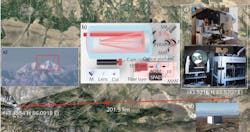Long-range 3D imaging now possible via single-photon imaging
High-efficiency optical devices coupled with a new noise-suppression technique have allowed researchers from the University of Science and Technology of China (Hefei, China) to reach long distances with single-photon imaging. The compact coaxial single-photon lidar system is capable of 3D imaging at up to 201.5 km, with as few as 0.44 signal photons per pixel.
According to the study, these results represent “a significant step toward practical, low-power lidar over extra-long ranges,” ideal for applications in target recognition and satellite-based topography for Earth observation.1
Led by professors Jian-Wei Pan and Feihu Xu, the work began with the development of optimized transceiver optics and a low-noise indium gallium arsenide/indium phosphide (InGaAs/InP) single-photon avalanche diode (SPAD) detector that reached a 19.3% detection efficiency and a low dark count rate (0.1 kHz). The transceiver system features a Cassegrain telescope with a modest aperture of 280 mm as well as an integrated optical platform mounted on a two-axis rotating stage. The researchers used a near-infrared wavelength of 1550 nm to reach high atmospheric transmittance and low solar background (see figure).
The researchers additionally developed an efficient temporal filtering technique for noise suppression; this helped differentiate weak echo signals from strong background noise, which is efficient for long-range applications.
Typically, the number of echo signal photons is highly limited with long-range lidar. With the low-noise SPAD, background noise is derived from two types of backscattering noise:
1. Backscatter of the laser pulse from the near-field atmosphere and the common transmitting/receiving optics elements. Atmospheric scattering lasts a long time after each pulse emission; and
2. The backscatter of amplified spontaneous emission (ASE) noise, which the researchers note is “unavoidable due to the required optical amplification.” This occurs in the full temporal domain of the detection. Neither type of noise can be removed by conventional operation of the SPAD system.
An efficient temporal filtering approach for noise suppression was also used. The researchers set a temporal separation of the emission mode and the detection mode, and employed an additional high-extinction-ratio acoustic optical modulator (AOM) to allow fast switching between those two modes. In the emission mode, laser pulses are triggered at a high repetition rate; the SPAD is turned off using electrical gating. With detection mode, the laser stops emitting pulses and the SPAD is turned on. According to the study, this can essentially eliminate local noise from the pulse emission (originally 2.4 nW coupled into the SPAD) and reduce the noise by a factor of 100.
The study found the noise suppression technique can reduce the total number of noise photon counts to about 0.4 kHz, at least 50X smaller than previous work.
The lidar system setup implemented a coaxial scanning design for the transmit and receive optical paths; this can align the transmitting and receiving spots more precisely and achieve higher collection efficiency and higher-resolution imaging than other traditional methods.
REFERENCE
1. Z.-P. Li et al., Optica (2021); doi.org/10.1364/optica.408657.
About the Author
Justine Murphy
Multimedia Director, Digital Infrastructure
Justine Murphy is the multimedia director for Endeavor Business Media's Digital Infrastructure Group. She is a multiple award-winning writer and editor with more 20 years of experience in newspaper publishing as well as public relations, marketing, and communications. For nearly 10 years, she has covered all facets of the optics and photonics industry as an editor, writer, web news anchor, and podcast host for an internationally reaching magazine publishing company. Her work has earned accolades from the New England Press Association as well as the SIIA/Jesse H. Neal Awards. She received a B.A. from the Massachusetts College of Liberal Arts.

